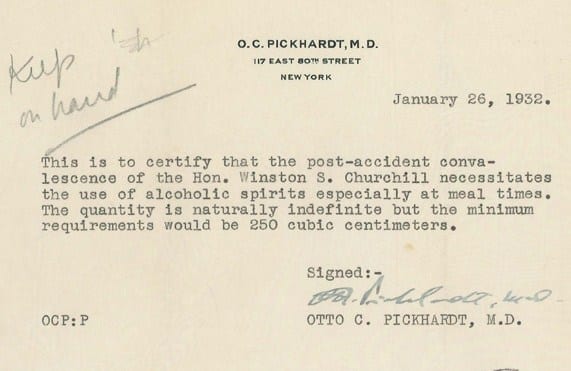Funtabulously Frivolous Friday Five 262
Just when you thought your brain could unwind on a Friday, you realise that it would rather be challenged with some good old fashioned medical trivia FFFF, introducing the Funtabulously Frivolous Friday Five 262
Question 1
What is Goodhart’s law?
Reveal the funtabulous answer
Named after economist Charles Goodhart who advanced the idea in his 1975 paper to critizise Margaret Thatcher’s conservative govenment’s monetary policy:
Any observed statistical regularity will tend to collapse once pressure is placed upon it for control purposes.
It has been paraphrased as…
When a measure becomes a target, it ceases to be a good measure.
Perhaps controversially we could consider the 4hr target in emergency departments. While the concept of patients been seen in a timely manner and getting the need expertise fast is noble, people start to game the system to reach this target and loose sight of the initial concept.
Reference: Goodhart, Charles (1981). “Problems of Monetary Management: The U.K. Experience”. Anthony S. Courakis (ed.), Inflation, Depression, and Economic Policy in the West. Rowman & Littlefield: 111–146.
Question 2
Who drank a cholera-inoculated broth to disprove Koch’s germ theory of cholera… and what happened?
Reveal the funtabulous answer
Max von Pettenkofer (3 December 1818 – 10 February 1901) was a Bavarian chemist and hygienist. He is known for his work in practical hygiene, as an apostle of good water, fresh air and proper sewage disposal.
During his career his position as a strong proponent of public health at times placed him at odds with his contemporaries, most notably Robert Koch. During his career Koch identified and isolated a large number of bacterial strains and was a supporter of the theory that these germs were the main causes of disease.
During the early 1850s there were epidemics of cholera and typhoid in Munich which led Pettenkofer to investigate John Snow’s thesis that they were water-borne. The results of his investigation convinced him that the cause lay in the moisture content of the soil which varied with the rise and fall of ground water.
He steadfastly refused to believe in the germ theory and is said to have drunk a vial of water contaminated by Vibrio cholerae which was sent to him by Robert Koch.
He consumed the bouillon in a self-test in the presence of several witnesses on 7 October 1892. He also took bicarbonate of sodato neutralise his stomach acid to counter a suggestion by Koch that the acid could kill the bacteria. Pettenkofer suffered mild symptoms for nearly a week but claimed these were not associated with cholera. The modern view is that he did indeed have cholera, but was lucky to just have a mild case and he possibly had some immunity from a previous episode
There is a theory that this episode was a death wish in disguise as, after losing his wife and three of his children, he sank into depression and committed suicide.
Reference: Max von Pettenkofer (1818-1901) – London School of Hygiene and Tropical Medicine.
Question 3
What is gizmo idolatry?
Reveal the funtabulous answer
Gizmo idolatry refers to the general implicit conviction that a more technological approach is intrinsically better than one that is less technological unless, or perhaps even if, there is strong evidence to the contrary. (Excerpted from Leff and Finucane, 2001)
Seven overlapping categories of incentives encourage clinicians and patients to favour the use of gizmos:
- Common sense appeale.g. drug-eluting stents.
- Human love of bells and whistlese.g. nebulisers vs MDI for asthma; IV fluid vs ORS for gastroenteritis.
- Exploits versus uneventful diligencee.g. the allure of surgery – e.g. for low back pain, when simple measures are just as effective.
- Gizmo Utilization as Proof of Competencee.g. the mantle of expertise from being first or ‘cutting edge.’
- Gizmo as Source of Objective, Quantifiable Informatione.g. pre-operative tests, even though they don’t improve outcomes; MRI for vague neurological complaints.
- Proof Against Negligence – belief that use of technology presents a higher standard and more defensible level of care.
- Channeling Money – business models created around gizmos, e.g. prostate irradiation therapy techniques.
Reference: Gizmo Idolatry.
Question 4
Who gets Dementia Pugilistica?
Reveal the funtabulous answer
Boxers.
Dementia pugilistica, is commonly referred to as punch-drunk syndrome, due to the fact that it was originally discovered in boxers in the 1920s (Martland). The term itself derives from the Latin word pugil, which translates as “boxer” or “fighter.” It occurs in people who have suffered multiple concussions, and it commonly manifests itself as dementia – or declining mental ability – along with problems with memory, and Parkinsonism.
The correct term is now chronic traumatic encephalopathy first used in 1949 by Dr. Macdonald Critchley, again referring to boxing.
Reference: Martland, H. S. (1928). Punch Drunk. Journal of the American Medical Association, 91(15),1103-1107. doi:10.1001/jama.1928.02700150029009
Critchley, M. (1949). Punch-Drunk Syndromes: The Chronic Traumatic Encephalopathy of Boxers. Maloin.
Question 5
What utility do the songs; Rumour Has It (Adele), Say You’ll Be There (Spice Girls), Sweet Home Alabama (Lynyrd Skynyrd) and Body Movin’ (Beastie Boys) have in the emergency department?
Reveal the funtabulous answer
All of these songs are 100 bpm and therefore should be played at full blast when performing CPR (depending on patient and family wishes – they maybe more of a ‘Stayin Alive’ – Bee Gees person.
For the full 47 song playlist complied by nyphospital on spotify follow the link.
…and finally
If you can’t stay safe, stay drunk
Winston Churchill Gets a Doctor’s Note to Drink “Unlimited” Alcohol in Prohibition America (1932)

FFFF
Funtabulously Frivolous Friday Five
Dr Neil Long BMBS FACEM FRCEM FRCPC. Emergency Physician at Kelowna hospital, British Columbia. Loves the misery of alpine climbing and working in austere environments (namely tertiary trauma centres). Supporter of FOAMed, lifelong education and trying to find that elusive peak performance.



